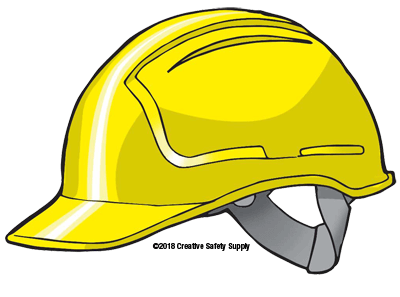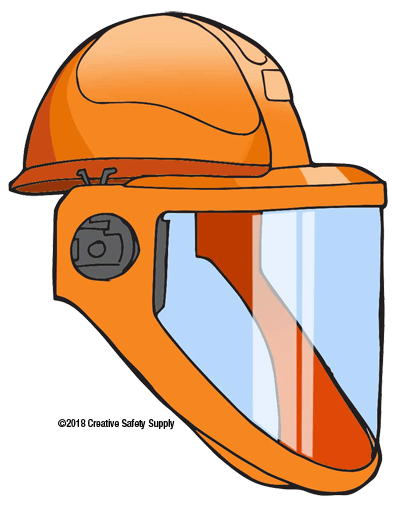
Hard hats are some of the most common pieces of personal protection equipment found in places such as construction sites, manufacturing facilities, and mining operations. OSHA has several rules when it comes to using hard hats, they must be worn when:
- There is a high risk of objects falling from above
- If there are fixed objects that employees may bump into
- If there are electrical hazards present where workers have a high risk of contact
Those are all very different hazardous situations requiring several different classes of hard hats to choose from. Each one is specifically designed to provide protection against certain types of hazards. Hard hat classes are largely determined by ANSI’s Z89.1-2014 standard.
This PPE is absolutely required for when employees face hazardous conditions that present a danger to their head and face area. Both safety managers and employees need to understand the importance of hard hats and how to choose the right ones for each situation. With that being said, this article is here to help you learn about the differences in hard hat classes.
ANSI Hard Hat Types

Most OSHA approved hard hats, that also comply with ANSI Z89.1, are made of high-density polyethylene (HDPE). Take a look inside a hard hat and you’ll notice what are commonly referred to as suspensions. There are a handful of load bearing points on the suspension mechanism that prevent the hard hat itself from resting on the employee’s head, providing an excellent barrier against blunt impact.
Aside from that similarity, hard hat characteristics start to deviate in terms of protection. The first way hard hats are broken up into different categories is based on the type of hard hat.
Type 1 Hard Hats
Type I hard hats are designed specifically to provide protection from falling objects. This type of head protection is commonly used at construction sites and other areas where work is done high above the ground. This is because high elevation work comes with an increased likelihood of falling objects causing injury, which is why type 1 hard hats are a necessity in these types of environments.
Type 2 Hard Hats
Type II hard hats provide protection from falling objects, but they also offer protection from lateral impact. This could be from running into the corner of a steel beam, having a projectile fly across a room, or any other risk to the sides or back of the head.
ANSI Classes of Hard Hats
In addition to the type categories of hard hats, there are also several classes of hard hats. The classes determine what types of hazards hard hats will protect wearers from. Having the right class of hard hat can mean the difference between life and death in many situations, so having the right option is essential.
Class G (General Hard Hats)
Class G hard hats are general use hard hats and are the most commonly found hard hats available. They do provide some protection against electricity, but only up to 2200 volts. The primary use for this class of hard hat is to protect against impact hazards.
Class E (Electrical Hard Hats)

Class E hard hats are approved for use in areas where exposure to electrical hazards is a possibility. To qualify as a class E electrical hard hat, one must provide the wearer with dielectric protection of as much as 20,000 volts.
Class C (Conductive Hard Hats)
Class C hard hats are not intended to provide any protection against electrical hazards. Instead, conductive hard hats are designed just to protect from impact hazards. In most cases, a class C hard hat will have built-in vents to help keep the wearer cool, which is why they are commonly found in hot factories or construction yards.
Updated OSHA Hard Hat Requirements
The seventh revision of the ANSI/ISEA Z89.1-2014 that companies must follow for OSHA compliance was changed in the following ways:
- Component manufacturers must prove that their accessories and helmet components do not cause failure while the safety helmet is in use.
- Additional language was added in the instructions and markings section to clarify that listing the “useful service life” is not required. It is up to the manufacturer on whether to include it or not.
- Lastly, the temperature for optional preconditioning was raised from 120º F to 140 º F and designated with an HT marking.
The standard also lists the need to label the inside of hard hats with the following information:
- The manufacturer’s name or an identifying mark
- The date of Manufacture
- ANSI Z89.1-2014 legend
- The Type and Classification of the hard hat
- A head size range
If optional performance features are applicable to that particular hard hat, it must show the following marking(s):
- Reverse Donning
- LT - Lower Temperature
- HV - High Visibility
- HT - Higher Temperature
Choosing the Right Hard Hat
Picking the right hard OSHA certified hard hat also comes with some rules:
- The hard hat classifications must be sufficient enough for the environment that employees are exposed to
- The hat must be able to resist impact, penetration, and electrical shock when required
- Regular inspection must be performed by the employee using the hard hat, with initial testing done by the manufacturer
These OSHA regulations can be found in CFR 29 1910.135, which lists ANSI’s Z89.1 standard as one that has been incorporated by reference. Look deeper into these regulations to gain a full understanding of what is required of you as the employer or employee when it comes to head protection. Picking the right head protection is critical for injury prevention.
Similar Articles
- ANSI/ISEA Z87.1 Standard [Eye Protection + Safety Glasses]
- What is a Noise Reduction Rating? [ANSI S3.19 Explained]
- What are ANSI standards?
- PPE: Personal Protective Equipment [Safety Standards]
- Arc Flash and Electrical Safety
- Arc Flash PPE
- OSHA Card [Program Requirements + Benefits]
- Electrical Wiring (Wire Color Codes)
- Electrical Wire Colors


